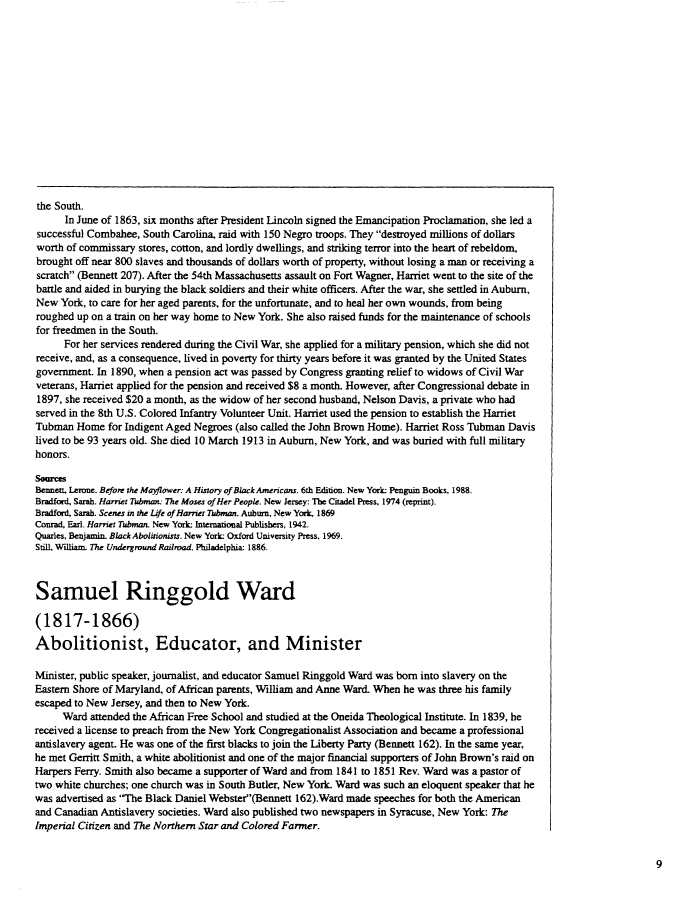 |
||||
|
TASK FORCE TO STUDY THE HISTORY AND LEGACY OF SLAVERY IN MARYLAND (Final Report) 1999/12/31 MdHR 991422 MdHR 991422, Image No: 369 Print image (81K) |
 |
||||
|
TASK FORCE TO STUDY THE HISTORY AND LEGACY OF SLAVERY IN MARYLAND (Final Report) 1999/12/31 MdHR 991422 MdHR 991422, Image No: 369 Print image (81K) |
| the South. In June of 1863, six months after President Lincoln signed the Emancipation Proclamation, she led a successful Combahee, South Carolina, raid with 150 Negro troops. They "destroyed millions of dollars worth of commissary stores, cotton, and lordly dwellings, and striking terror into the heart of rebeldom, brought off near 800 slaves and thousands of dollars worth of property, without losing a man or receiving a scratch" (Bennett 207). After the 54th Massachusetts assault on Fort Wagner, Harriet went to the site of the battle and aided in burying the black soldiers and their white officers. After the war, she settled in Auburn, New York, to care for her aged parents, for the unfortunate, and to heal her own wounds, from being roughed up on a train on her way home to New York. She also raised funds for the maintenance of schools for freedmen in the South. For her services rendered during the Civil War, she applied for a military pension, which she did not receive, and, as a consequence, lived in poverty for thirty years before it was granted by the United Stales government. In 1890, when a pension act was passed by Congress granting relief to widows of Civil War veterans, Harriet applied for the pension and received $8 a month. However, after Congressional debate in 1897, she received $20 a month, as the widow of her second husband, Nelson Davis, a private who had served in the 8th U.S. Colored Infantry Volunteer Unit. Harriet used the pension to establish the Harriet Tubman Home for Indigent Aged Negroes (also called the John Brown Home). Harriet Ross Tubman Davis lived to be 93 years old. She died 10 March 1913 in Auburn, New York, and was buried with full military honors. Sources Bennett, Lerone. Before the Mayflower: A History of Black Americans. 6th Edition. New York; Penguin Books, 1988. Bradford, Sarah. Harriet Tubman: The Moses of Her People. New Jersey: The Citadel Press, 1974 (reprint). Bradford, Sarah. Scenes in the Life of Harriet Tubman. Auburn, New York, 1869 Conrad, Earl. Harriet Tubman. New York: International Publishers, 1942. Quarles, Benjamin. Black Abolitionists. New York: Oxford University Press, 1969. Still, William. The Underground Railroad. Philadelphia: 1886. Samuel Ringgold Ward (1817-1866) Abolitionist, Educator, and Minister Minister, public speaker, journalist, and educator Samuel Ringgold Ward was bom into slavery on the Eastern Shore of Maryland, of African parents, William and Anne Ward. When he was three his family escaped to New Jersey, and then to New York. Ward attended the African Free School and studied at the Oneida Theological Institute. In 1839, he received a license to preach from the New York Congregationalist Association and became a professional antislavery agent. He was one of the first blacks to join the Liberty Party (Bennett 162). In the same year, he met Geiritt Smith, a white abolitionist and one of the major financial supporters of John Brown's raid on Harpers Ferry. Smith also became a supporter of Ward and from 1841 to 1851 Rev. Ward was a pastor of two white churches; one church was in South Butler, New York. Ward was such an eloquent speaker that he was advertised as 'The Black Daniel Webster"(Bennett 162).Ward made speeches for both the American and Canadian Antislavery societies. Ward also published two newspapers in Syracuse, New York: The Imperial Citizen and The Northern Star and Colored Farmer. |